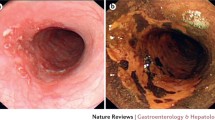Summary
The image resolution of fiberoptic and video endoscopy was compared in a series of patients with early gastric cancer. Eighteen patients were divided into two groups. One group of patients (n=9) was evaluated with fiberoptic endoscopy while the second group (n=9) was evaluated using video endoscopy. The extent of cancer invasion, with special attention to size, shape and type of the lesions, was evaluated in each patient. Attempts were also made to identify the proximal and distal limits of tumor invasion and the endoscopic and postoperative findings were compared. Endoscopic delineation of lesions was possible in more patients undergoing video endoscopy compared to fiberoptic endoscopy. Video endoscopy gave better endoscopic images for determination of the limits and of the size of cancer invasion. Indigo dye spraying enhanced the accuracy rates in both groups of patients. The results of this study suggest that video endoscopy may be more useful than fiberoptic endoscopy in the evaluation of minimal mucosal changes of the gastrointestinal tract. We believe that video endoscopy may have a useful role in the gastrointestinal endoscopy if the problem of expense, which is its main drawback, can be solved.
Similar content being viewed by others
References
Classen M, Phillip J (1984) Electronic endoscopy of the gastrointestinal tract: initial experience with a new type of endoscope that has no fiberoptic bundle for imaging. Endoscopy 16: 16–19
Demling L, Hagel HJ (1985) Video endoscopy, fundamentals and problems. Endoscopy 17: 67–69
Doi T, Miyahara T, Kanazawa M, Watanabe K, Kawaguchi J, Rikitake K, Iwashita E, Hayashi T, Takehara M, Nomura T, Kogayashi M, Adachi Y, Miura K, Shigeaki N, Niwa H (1988) Diagnostic significance of image enhancement for electronic endoscopic pictures — clinical evaluation of image enhancement using the component of RGB. Gastroenterol Endosc 30: 1887–1894
Osaka N, Shiraki M, Miyoshi H, Ashida K, Orino S, Tei H, Hayashi K, Okumura Y, Matumoto A, Hirata I, Oshiba S (1988) Basic study of the image evaluation of electronic endoscopes. Gastroenterol Endosc 30: 936–941
Rey JF, Albussion M, Greff M, Bidart JM, Monget JM (1988) Electronic video endoscopy: preliminary results of imaging modification. Endoscopy 20: 8–10
Satava RM (1987) A comparison of direct and indirect video endoscopy. Gastrointest Endosc 33: 69–72
Silverstein FE (1988) The future of video endoscopy. Gastrointest Endosc 34: 361–362
Tatsuta M, Okuda S, Tamura H, Taniguchi H (1982) Endoscopic determination of the extent of early ulerated gastric cancer by the congo red test. Endoscopy 14: 41–44
Tsuji S, Sato N, Kawano S, Kamada T (1988) Functional imaging for the analysis of the mucosal blood hemoglobin distribution using electronic endoscopy. Gastrointest Endosc 34: 332–336
Author information
Authors and Affiliations
Rights and permissions
About this article
Cite this article
Demirci, S., Gohchi, A. A comparative study for fiberoptic and video endoscopic determination of the extent in minimal changes of gastric mucosa using indigo dye spraying. Surg Endosc 4, 80–82 (1990). https://doi.org/10.1007/BF00591263
Issue Date:
DOI: https://doi.org/10.1007/BF00591263




